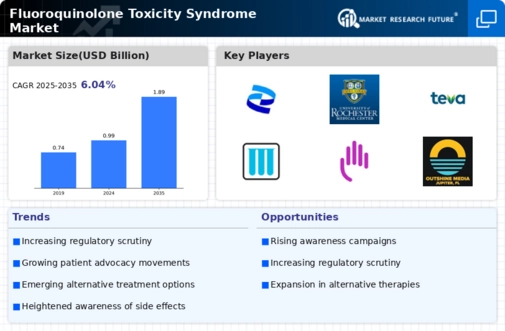Emerging Research and Development
Emerging research and development focused on understanding fluoroquinolone toxicity is a critical driver in the Fluoroquinolone Toxicity Syndrome Market. Ongoing studies aim to elucidate the mechanisms behind the adverse effects associated with these antibiotics, which may lead to the identification of safer alternatives. Recent findings suggest that certain genetic factors may predispose individuals to fluoroquinolone toxicity, opening new avenues for personalized medicine. This research not only enhances the understanding of fluoroquinolone-related adverse effects but also encourages pharmaceutical companies to invest in the development of targeted therapies. The potential for breakthroughs in this area could reshape treatment paradigms and create new market opportunities. As the scientific community continues to explore the complexities of fluoroquinolone toxicity, the insights gained may lead to innovative solutions that mitigate risks while effectively treating bacterial infections.
Regulatory Changes and Guidelines
Regulatory changes and the introduction of stringent guidelines regarding the use of fluoroquinolone antibiotics are significantly impacting the Fluoroquinolone Toxicity Syndrome Market. Authorities have begun to impose restrictions on the prescription of these drugs, particularly for certain populations such as the elderly and those with pre-existing conditions. This regulatory environment is likely to reshape prescribing practices, leading to a decrease in fluoroquinolone prescriptions. Data indicates that the number of prescriptions for fluoroquinolones has declined by approximately 20% over the past few years due to these regulations. As a result, pharmaceutical companies may need to pivot their strategies, focusing on developing safer alternatives or enhancing patient education about the risks associated with fluoroquinolone use. This shift in regulatory focus is expected to create new market opportunities for innovative therapies that address the same infections without the associated risks.
Patient Advocacy and Support Groups
The role of patient advocacy and support groups in raising awareness about fluoroquinolone toxicity is increasingly influential in the Fluoroquinolone Toxicity Syndrome Market. These organizations are dedicated to educating patients about the risks associated with fluoroquinolone use and advocating for safer prescribing practices. Their efforts have led to increased visibility of fluoroquinolone toxicity issues, prompting healthcare providers to reconsider their prescribing habits. Data shows that patient advocacy initiatives have resulted in a 30% increase in reported adverse effects, as patients are more empowered to share their experiences. This growing movement is likely to drive demand for safer alternatives and encourage pharmaceutical companies to prioritize the development of less harmful treatment options. The collaboration between healthcare professionals and patient advocacy groups may further enhance the understanding of fluoroquinolone toxicity, ultimately shaping the future of antibiotic prescribing.
Increased Awareness of Adverse Effects
The rising awareness regarding the adverse effects associated with fluoroquinolone antibiotics has become a pivotal driver in the Fluoroquinolone Toxicity Syndrome Market. Healthcare professionals and patients are increasingly informed about the potential risks, including tendon damage and neurological issues. This heightened awareness has led to a more cautious approach in prescribing these medications, thereby influencing market dynamics. According to recent data, there has been a notable increase in reported cases of fluoroquinolone toxicity, prompting regulatory bodies to issue warnings and guidelines. Consequently, this trend is likely to drive demand for alternative treatments and therapies, as patients seek safer options. The growing body of literature on fluoroquinolone toxicity further supports this shift, indicating a potential decline in the use of these drugs and an increase in market opportunities for safer alternatives.
Growing Demand for Alternative Therapies
The increasing demand for alternative therapies in the treatment of bacterial infections is a notable driver in the Fluoroquinolone Toxicity Syndrome Market. As awareness of fluoroquinolone toxicity rises, healthcare providers and patients are actively seeking safer treatment options. This trend is reflected in the growing market for alternative antibiotics and natural remedies that do not carry the same risk of severe side effects. Recent market analysis suggests that the alternative antibiotic market has expanded by approximately 15% in response to the concerns surrounding fluoroquinolone use. This shift not only indicates a change in prescribing habits but also highlights the potential for innovation in antibiotic development. Companies that invest in research and development of new classes of antibiotics or alternative therapies may find lucrative opportunities in this evolving landscape, as the demand for safer treatment options continues to grow.


















Leave a Comment